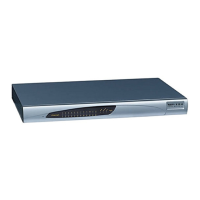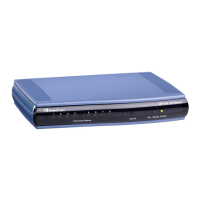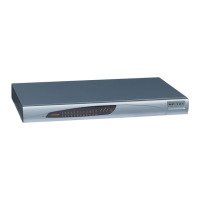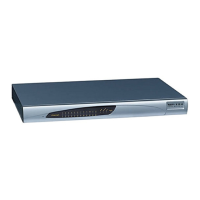Example 2: Three Interfaces, one for each application exclusively - the Multiple
Interface table is configured with three interfaces, one exclusively for each application type:
one interface for OAMP applications, one for Call Control applications, and one for RTP
Media applications:
Table 10-11: Multiple Interface Table - Example 2
Index Application Interface IP Address
Prefix
Length
Default
Gateway
VLAN
ID
Interface
Name
0 OAMP IPv4 192.168.85.14 16 0.0.0.0 1 ManagementIF
1 Control IPv4 200.200.85.14 24 0.0.0.0 200 myControlIF
2 Media IPv4 211.211.85.14 24 211.211.85.1 211 myMediaIF
VLANs are required. The 'Native' VLAN ID is the same VLAN ID as the Management
interface (Index 0). One routing rule is required to allow remote management from a host in
176.85.49.0 / 24:
Table 10-12: Routing Table - Example2
Destination Prefix Length Subnet Mask Gateway Interface Metric
176.85.49.0 24 192.168.0.1 0 1
All other parameters are set to their respective default values. The ini file matching this
configuration can be written as follows:
; Interface Table Configuration:
[InterfaceTable]
FORMAT InterfaceTable_Index = InterfaceTable_ApplicationTypes,
InterfaceTable_InterfaceMode, InterfaceTable_IPAddress,
InterfaceTable_PrefixLength, InterfaceTable_Gateway,
InterfaceTable_VlanID, InterfaceTable_InterfaceName;
InterfaceTable 0 = 0, 10, 192.168.85.14, 16, 0.0.0.0, 1, ManagementIF;
InterfaceTable 1 = 2, 10, 200.200.85.14, 24, 0.0.0.0, 200, myControlIF;
InterfaceTable 2 = 1, 10, 211.211.85.14, 24, 211.211.85.1, 211,
myMediaIF;
[\InterfaceTable]
; VLAN related parameters:
VlanMode = 1
VlanNativeVlanId = 1
; Routing Table Configuration:
RoutingTableDestinationsColumn = 176.85.49.0
RoutingTableDestinationPrefixLensColumn = 24
RoutingTableGatewaysColumn = 192.168.0.1
RoutingTableInterfacesColumn = 0

